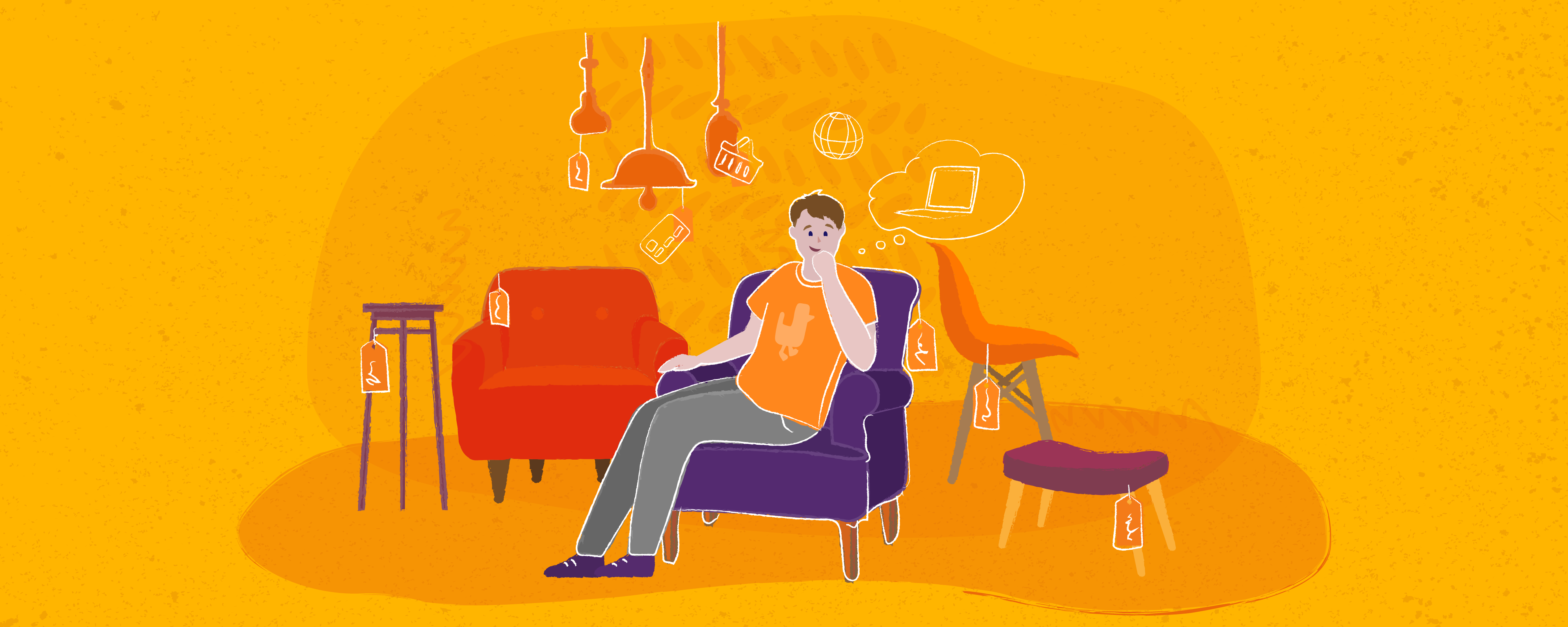Top 10 Sales Development Trends / Furniture Industry
For the furniture industry, the optimization of various sales channels both online and offline, is of critical importance. 2023 is a good time to put certain areas and processes in order, plan support activities, and develop e-commerce sales. To help you prepare for future growth, take advantage of upcoming opportunities and anticipate challenges, we present an overview of the most popular sales development trends in the furniture industry.
This sector is particularly important to us, as we have the pleasure of supporting leaders of this industry in their e-commerce activities. In writing this article, we have invited a number of experts to share their experiences with us.
Trend 1: D2C – Direct to Consumer
D2C is a business model that is attracting increasing interest from businesses, including in the furniture industry. According to the Barclays Corporate Banking report on the UK market, the number of deliveries made as part of D2C transactions is expected to increase by 30% between 2020 and 2023. In the D2C model, manufacturers sell their products directly to end customers without the use of intermediaries. D2C is a big challenge for brands – it requires a new model of customer service, marketing activities and logistics, as well as the acquisition of new skills for the team. However, it’s worth taking up this challenge, as direct contact with customers and selling products through your own online store or marketplace platform can bring many benefits. One of those benefits is control over retail prices and the ability to apply higher margins. The D2C model is usually chosen to diversify sales channels, remove intermediaries and expand the market. It is also an opportunity to reach new customer groups.
“Those manufacturers who sell directly gain knowledge about the customers and users of their products. This, in turn, makes it easier to manage customer experience, control and streamline the customer journey and improve the product proposition.” says Mariusz Nowak, E-commerce & Omnichannel Strategy Director, Black Red White.

Trends 2: Marketplace
The increased customer interest in shopping on marketplace platforms confirms that the implementation of the D2C model in the furniture industry was a good move. Using a platform which has a recognizable brand and ranks high in search engines facilitates the launch of online sales without having your own online store, end-customer service or payment system. Mariusz Nowak says: “Marketplace has become the prevailing business model in the e-commerce segment, accounting for over 60% of the global online sales market.”
The expert also points out that next to large players, such as Allegro or Amazon, smaller, vertical marketplaces are emerging, taking up specific niches. With high customer interest, they quickly gain a leading position in their respective business fields. Consumers value convenience above anything else and no longer want to waste time shopping around for the right product in multiple online stores. Observing this trend, furniture manufacturers and distributors have two options: cooperate with a well-known marketplace platform or create their own.
Trend 3: Omnichannel
In the furniture industry, sensory experiences still matter – customers wish to touch the product before buying it, even if they want to make the purchase online. This is a challenge for companies that have always operated online only. On the other hand, customers who come to a brick-and-mortar store expect to get benefits typically offered in the online channel, such as a deferred payment plan.
For this reason, more and more brands in the industry skillfully combine different, complementary sales channels. Physical stores have the role of showrooms, where furniture and accessories found online can be viewed, ordered and collected on site (ROPO – Research Online, Purchase Offline). In turn, online customers use applications to visualize furniture from an online store. The omnichannel approach integrates various sales channels and helps in reaching a wide group of buyers – both traditional ones and those who prefer modern, online shopping.
Mariusz Nowak notes: “Once the pandemic has subsided, the omnichannel business model has again gained importance. Customers have returned to physical stores, but they are looking for experiences similar to those they already know from the digital world. They want to use deferred payments and BLIK payments, as well as pick up and return products ordered online in offline stores.”
Trend 4: E-commerce Adapted to the Needs of Furniture Industry Customers
Modern e-commerce platforms support sales while ensuring the replication of the in-store experience. Here we can point to the likes of extensions for product personalization, as well as 3D visualizations of interiors for which no graphic software is needed.
Fully integrated with systems for managing products on offer, inventory, logistics and product information, such platforms are stable and scalable. Modern e-commerce options are foreign-sales ready and meet omnichannel needs.
Distribution in new channels is additionally facilitated by additional software, such as PIM systems, which improve product information management. PIMs support the development of sales in the cross-border model, which is a natural stage of development for companies from the furniture industry.
Trend 5: Development of Mobile Commerce
When developing sales in the furniture industry, we cannot shy away from emerging solutions, but we also need to note the solutions that have been available for several years and are being constantly developed. For many companies, the number one option is the ability to present their products on mobile devices. “In selected markets, we see that 80% of customers use our online store via mobile phone, and this is how they make their purchases. We’re currently working on improving the product search engines in our store to support voice search. We believe that, in the future, most people will use the voice assistant to find specific items.” says Łukasz Rabiega, CEO of Mirjan24, Mir-Tex24.
Trend 6: Optimizing the Physical Sales Network
Due to the rising costs and the development of digital sales channels, manufacturers will have no option but to optimize their physical sales networks – close down unprofitable locations, downsize the network or change the format of some stores. A possible scenario is to reduce the number of stores by replacing them with showrooms that fit into the omnichannel strategy. As already mentioned, physical showrooms have a very important position in the furniture industry. In Poland, as an example of a European country (and also where we live!) around 81% of customers in 2022 made an in-store purchase, even if the initial decision to buy had been made earlier based on photos and descriptions seen on the internet or in a mobile device. However, as we can observe in our domestic market, the percentage of online purchases is expected to increase to 25% by 2025. And we can assure you that Pole’s don’t just have some weird shopping habits compares to our neighbours!
Trend 7: Cross-border
Both Poland and Germany are among the top 5 furniture exporters in the world. The former sells across both Europe and United States for example. The latter, on the other hand, is also a key target market, with 33% of imported furniture coming from Poland. Global rankings also show that the UK, Czech Republic and France are some of the lowest consumers, importing 20% or less. So in other words, big importers are also big exporters, and consumers don’t just buy locally.
Cross-border sales are currently one of the most promising features of the furniture sector’s business growth strategy. Along with the change in consumer sentiment and the decline in purchasing power, furniture brands are looking for new market expansion opportunities. You can start your cross-border business from distribution through the marketplace or by investing in your own e-commerce. Remember to adapt it to international sales (multi-currency, support for different languages, improved product information management with the PIM system and integration with local payment and logistics operators).
“Logistics has always been the biggest challenge for the cross-border sale of bulky products. Today, more and more operators offer home delivery services to the markets of Central and Western Europe, most often with the support of a local partner. Furniture retailers can also use the fulfillment service so as not to worry about last-mile delivery.” says Mariusz Nowak.
Trend 8: Data Science in the Furniture Industry
Data and information are key to making quick and accurate decisions, especially in uncertain times. Łukasz Rabieg says: “Tables, graphs and numbers don’t lie – they directly show whether you are on track to reach your target or if you need to correct your course. With various tables and summaries, you can measure the efficiency of logistics, marketing, sales, and keep track of the potential of new products and markets.” You may also use data science to optimize inventory levels and increase conversion.
Trend 9: More for Less
At a time of rampant inflation and rising costs, buyers become more price sensitive. Many customers postpone larger and more expensive purchases of non-essential products, decide to buy a cheaper item or give up buying it altogether. It may be necessary to reorient the product range towards a more economical segment. This does not mean, however, that there will be no demand for premium products, where high quality is the primary value. We only point out that customers will shop more carefully and it’s worth taking this into account when setting the company’s price and product policy.
Trend 10: A Variety of Payment Methods
When analyzing customer needs, we can’t help but notice the growing popularity of deferred payment and installment plans. The first option allows buyers to pay for purchases after a certain period, which is usually 30 days, or to pay in installments with a low-interest rate. In turn, the classical installment payment must be paired with the banking system that is used to process the transaction. Those payment models are of particular importance in the furniture industry, where impulse purchases are rare. As furniture is usually bought for years and is a big expense, customers are currently looking for the best possible payment methods. This is also linked to the tendency to split furniture purchases into stages, which can be correlated with deferred payments.
Ensuring a wide range of online payment methods will improve the comfort of shopping and boost customer experience. Payments also play an important role in differentiating sales strategies to meet the needs of individual markets. “As part of Mirjan24, we operate in the markets of both Western and Eastern Europe. With such a major cross-cultural presence, we can observe differences as to the preferred payment methods. When operating in a given region, you must be ready to offer various solutions that will inspire the greatest trust of your potential customers from that country. Very often, you’ll be surprised by the sheer range of online payment methods.” Łukasz Rabiega notes.

SUMMARY
In today’s increasingly competitive environment, entering the online channel is just the beginning of the journey. That’s why we always recommend choosing a flexible and scalable e-commerce platform that will allow you to easily respond to changes. In the near future, we expect that “must haves” in the B2C model, such as recommendation engines, personalization and sales via marketplaces, will also become key to manufacturers and distributors in the furniture industry. Stay on top of those changes and gain the competitive advantage.
Want to learn more about the trends for furniture industry? Let’s talk!







